
Vietnam Journal
of Agricultural
Sciences
ISSN 2588-1299
VJAS 2023; 6(4): 1917-1923
https://doi.org/10.31817/vjas.2023.6.4.02
https://vjas.vnua.edu.vn/
1917
Received: July 25, 2023
Accepted: December 12, 2023
Correspondence to
nthyen@vnua.edu.vn
Identification of Three Toxocara species, T.
canis in Dogs, and T. cati and T.
malaysiensis in cats, in Vietnam by PCR-
RFLP Analysis and DNA Sequencing
Nguyen Thi Hoang Yen*, Nguyen Van Phuong, Duong Duc Hieu
& Nguyen Thi Lan Anh
Faculty of Veterinary Medicine, Vietnam National University of Agriculture, Hanoi
131000, Vietnam
Abstract
Toxocara canis and T. cati are common roundworms parasitizing
dogs and cats, respectively. However, a recent study detected T.
malaysiensis, but not T. cati, in cats from some parts of Ha Noi and
Nam Dinh Provinces raising the question of whether T. cati is present
in cats in Vietnam. This study was conducted to determine the
composition of Toxocara species in dogs and cats in Vietnam. One
hundred and twenty-seven Toxocara adult worms were collected
from dogs and cats and were analyzed by PCR-RFLP assay and DNA
sequencing of a partial section of the cox1 gene. As a result, all
samples amplified by PCR showed bands about 430 bp in length.
PCR products digested by MseI from isolates from cats and dogs
showed four and two restriction patterns, respectively. The six
different patterns were chosen to sequence. Based on the restriction
patterns and sequencing results, two Toxocara species were
identified in the cats, namely T. cati (110/111 isolates) and T.
malaysiensis (1/111 isolates) collected from Ha Noi and Hai Duong,
respectively; and T. canis was identified in the dogs (16/16 isolates).
In addition, the present study indicated intra-specific sequence
variations of Toxocara spp. in dogs and cats. In conclusion, the study
confirmed the presence of both T. cati and T. malaysiensis in cats,
and T. canis in dogs in Vietnam, and suggests further large-scale
investigations to fully understand the distribution and genetic
variations of Toxocara spp. in cats and dogs in Vietnam.
Keywords
Toxocara roundworm, Toxocara canis, Toxocara cati, Toxocara
malaysiensis, PCR-RFLP.
Introduction
Toxocara canis and Toxocara cati are common roundworms
parasitizing canids and felids, respectively. Both of them are also

Identification of three Toxocara species in cats in Vietnam by PCR-RFLP analysis and DNA sequencing
1918
Vietnam Journal of Agricultural Sciences
etiological agents causing human toxocariasis, a
zoonotic parasitic disease reported worldwide
(Magnaval et al., 2001). In 2001, a new Toxocara
species named T. malaysiensis was described in
cats from Malaysia, and since then, it has been
detected in China and Vietnam (Gibbons et al.,
2001, Li et al., 2006; Le et al., 2016). While T.
canis is the unique Toxocara species found only
in dogs (Nguyen Thi Quyen et al, 2016; Le et al.,
2016), Toxocara species composition in cats has
been questioned. In Vietnam, Toxocara spp. is
one of the most common roundworms in dogs
and cats (Nguyen Thi Hoang Yen et al., 2020;
Nguyen Thi Hoang Yen et al., 2022). The
prevalence of Toxocara spp. in dogs (34.6-
47.8%) has generally been found to be greater
than in cats (21.0-37.7%) (Anh et al., 2016;
Nguyen et al., 2020; Nguyen et al., 2022). T. cati
has been considered the predominant species in
cats in Vietnam (Le et al., 2016). However, a
recent study that detected T. malaysiensis, but
not T. cati, in domestic cats from Ha Noi and
Nam Dinh Provinces (Le et al., 2016) raised the
question of whether T. cati is present in cats
from Vietnam.
Traditionally, Toxocara species are
identified mainly based on their morphological
characteristics and predilection sites in a
particular host species (Kim et al., 2020).
However, misidentification may occur because
of morphological similarities between species,
such as the shape of the esophagus with a
ventriculus, dentigerous ridges on the lips, a V-
shaped cervical alae, spicules, and position of the
vulva opening (Gibbons et al., 2001);
meanwhile, molecular techniques using
ribosomal and mitochondrial DNA markers have
helped to obtain more accurate identifications
(Jacobs et al., 1997; Zhu et al., 2001; Gasser et
al., 2006; Pawar et al., 2012; Mikaeili et al.,
2017; Wang et al., 2018; Fava et al., 2020). PCR-
linked restriction fragment length polymorphism
(PCR-RFLP) developed by Fava is a time and
cost-saving method for distinguishing the three
Toxocara species, namely T. canis, T. cati and T.
malaysiensis, because it only requires a single
restriction enzyme (MseI) (Fava et al., 2020).
Thus, in this study, PCR-RFLP and DNA
sequencing were performed to differentiate and
confirm Toxocara species collected from dogs
and cats in Northern Vietnam.
Materials and Methods
Collection of roundworms and sample
processing
One hundred and twenty-seven adult worms
of Toxocara spp. were collected from naturally
infected dogs and cats (111 from 36 cats and 16
from 6 dogs) at veterinary clinics by
anthelminthic expulsion or local abattoirs by
necropsy around Ha Noi (Nam Tu Liem and Gia
Lam districts), and one Toxocara adult worm
was collected from a domestic cat in Tien Dong
commune, Tu Ky district, Hai Duong province.
They were preliminarily identified based on
macro-morphology, as Toxocara spp. have a
ventriculus intercalated between the esophagus
and the intestine, and males have a finger-like
tail, which is distinguished by tapering to a point
in Toxascaris leonina males (Bowman, 2014).
The roundworms were then thoroughly washed
several times in saline solution and kept in 70%
ethanol for molecular analyses.
DNA extraction and polymerase chain
reaction (PCR)
Total genomic DNA was extracted from
adult worms of Toxocara spp. by the alkaline
lysis method with a few slight changes. Firstly, a
piece (about 50mg) of the worm was cut and
transferred into a 1.5-mL Eppendorf tube,
followed by the addition of 1,800µL of 50mM
NaOH. The tubes were incubated at 95°C
overnight on a block heater. After that, 200 µl of
1 M Tris-HCl (pH 8.0) was added into each tube.
Next, the mixture was vortexed thoroughly and
centrifuged at 14,000 x g for 10 minutes. Finally,
the supernatant was transferred into a new tube
and then stored at -20°C until analysis (Nguyen
et al., 2016).
The total genomic DNA from each
individual worm was subjected to PCR assay
using the primer pair ToxCoIF
(5′GATTTTACCTGCTTTTGGTATTATTAG-
3′) and ToxCoIR (5′-
CCAAAGACAGCACCCAAACT-3′) (Fava et

Nguyen Thi Hoang Yen et al. (2023)
https://vjas.vnua.edu.vn/
1919
al., 2020) to amplify a 426-bp fragment of the
mitochondrial cox1 gene.
All PCR reactions were carried out in a total
volume of 50μL using 2μL of template DNA, 25
μl Mastermix 2X_100_tracking dye (Phusa
Biochem LTD. Company, Can Tho, Vietnam), 2
μl of each primer (10 pmol), and 19 μl distilled
water. The amplification conditions followed
those described in a previous study (Fava et al.,
2020). PCR products were electrophoresed on a
1.0% agarose gel in TAE at 100V for 30 minutes.
Gels were stained with GelRed® (Biotium,
Fremont, CA) and the bands were visualized
under UV light.
DNA sequencing analysis
PCR amplicons were purified and six
isolates were chosen for sequencing in both the
forward and reverse strands using the same
primers employed in the PCR by the Suran
Medical and Scientific Solutions Join Stock
Company (Hanoi, Vietnam). DNA sequences
were aligned using the Geneious Prime
Biomatters Company and compared with
sequences from the GenBank database via the
BLAST search tool.
PCR linked restriction fragment length
polymorphism (PCR-RFLP)
Six microliters (6µL) of each PCR product
were digested with 4 units of MseI (New England
Biolabs, Ipswich, MA) in a total volume of 15μL.
The mixture was incubated overnight at 37°C
and then electrophoresed on 2% agarose, stained
with GelRed®, and visualized using UV light.
Digestion products included three restriction
patterns: 95, 121, and 210bp (T. canis); 22, 44,
172, and 188bp (T. cati); and 44, 51, 121, and
210bp (T. malaysiensis) (Fava et al., 2020). To
estimate the sizes of the fragments, a 100-bp
molecular ladder (BioFact, Daejeon, Republic
Korea) was used. A negative control (distilled
water) was added to each run.
Results
A total of 127 samples were analyzed by
PCR assay, and all of them showed a band of
around 430bp (Figure 1). After digestion by the
MseI enzyme, six restriction fragment patterns
were observed from the PCR products, four
patterns in the Toxocara worms from cats, and
two other patterns in the Toxocara worms from
dogs. The first pattern had three clear bands
about 210, 120, and 40bp (Figure 2A, Tspcat1);
the second pattern had three clear bands with two
close bands about 190bp and one band about 44
bp (Figure 2A, Tspcat2-Tspcat6, Tspcat13;
Figure 2B, Tspcat52); the third one had four
clear bands about 190, 110, 60, and 40 bp
(Figure 2B, Tspcat22, Tspcat47); and the last
one had three clear bands about 190, 120, and
100bp (Figure 2B, Tspcat56). According to the
restriction patterns reported by Fava et al. (2020),
the first pattern in this study was expected to be
T. malaysiensis based on the specific band of 210
bp and the felid host; the following three patterns
were expected to be T. cati characterized by 190
bp bands. In the case of the dog Toxocara worms,
two restriction patterns of fragments were
observed, one had three bands of 210, 120, and
100bp (Figure 3, Tspdog1, Tspdog3); while the
other consisted of three bands of about 210, 120,
and 50bp (Figure 3, Tspdog4). In comparison to
the restriction patterns reported by Fava et al.
(2020), the former pattern was expected to be T.
canis based on the specific band of 210bp and the
canid host; and the latter pattern seemed to be T.
malaysiensis (Fava et al., 2020).
Analysis of the DNA sequences revealed
some variations in the sequences of the
restriction sites for MseI in both the cat and dog
isolates (Figure 4). MseI recognizes sites with
the sequence 5’-T*TAA-3’. The sequence of the
cox1 gene of T. malaysiensis contained three
cutting sites for MseI (black rectangles, Figure
4), thus four fragments of 44, 51, 121, and 210bp
were collected after digestion. For T. cati, the
isolate named Tspcat22 contained four cutting
sites, and produced five fragments of 22, 44, 63,
109, and 188bp. Two isolates, Tspcat52 and
Tspcat56, had three cutting sites but at different
positions, giving two different restriction
patterns of four fragments 22, 44, 172, and
188bp; and 22, 95, 121, and 188bp, respectively
(green rectangles, Figure 4). The fragments of
172 and 188bp were very close because they only

Identification of three Toxocara species in cats in Vietnam by PCR-RFLP analysis and DNA sequencing
1920
Vietnam Journal of Agricultural Sciences
Figure 1. Electrophoretic images of the PCR products of cox1 amplification of Toxocara spp. worms from cats and dogs. Lanes
Tspcat1, 22, 52, 47, 56, and 59 are Toxocara worms from cats; Lanes Tspdog 1, 2, 15, and 17 are Toxocara worms from dogs; and
Lane M: Marker. Black arrow shows 500bp position.
Figure 2. PCR-RFLP band patterns of the cox1 region using the endonuclease MseI. Lane M: Marker; Lanes Tspcat1, 2, 3, 4, 5, 6,
and 13 (A), and lanes Tspcat 47, 52, 56, and 22 (B) show the digested products of Toxocara worms from cats. Black arrow shows
the 500 bp position.
differed in size by 16bp, while the 22-bp fragment
was not clearly observed on the gel electrophoresis.
In the case of T. canis, the partial cox1 gene
of the sequence of Tspdog1 contained two
cutting sites for MseI, producing three fragments,
95, 121, and 210bp after digestion. The isolate
named Tspdog4 had three cutting sites,
producing four fragments of 44, 51, 121, and
210bp (red rectangles, Figure 4). Of note, we
recognized that the restriction fragment pattern
of Tspcat1 (T. malaysiensis) was similar to that
of Tspdogs4 (T. canis). Unfortunately, when
comparing the PCR-RFLP results and
sequencing, we recognized that the 22-bp band
was unclearly observed in the electrophoresis
results. Positions of the restriction enzyme sites
in the amplified cox1 region for the different
species of Toxocara and the sizes of the
fragments in each isolate are represented in
Table 1.
A
B

Nguyen Thi Hoang Yen et al. (2023)
https://vjas.vnua.edu.vn/
1921
Figure 3. PCR-RFLP band patterns of the cox1 region using the endonuclease MseI. Lane M: Marker; Lanes Tspdog1, 4 and 3
show the digested products of Toxocara worms from dogs. Black arrow shows the 500bp position.
Figure 4. Alignment of the cox1 sequences (426 bp) representing the distinct genetic variants among the Toxocara isolates from
cats and dogs. Rectangles are the locations of the MseI restriction sites: black represents T. malaysiensis, green represents T. cati,
and red represents T. canis.
In comparison to sequences deposited in
GenBank, only one isolate from cats was
identified as T. malaysiensis with 99.53%
identity to the reference sequence (GenBank

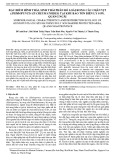



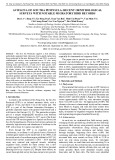

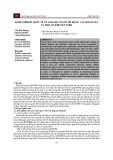
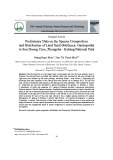
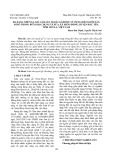
![Đề thi Vi nhân giống có đáp án - Trường TCDTNT-GDTX Bắc Quang (Đề số 2) [Mới nhất]](https://cdn.tailieu.vn/images/document/thumbnail/2023/20230712/nguyenducthang2001/135x160/8951689149552.jpg)















